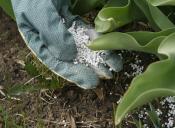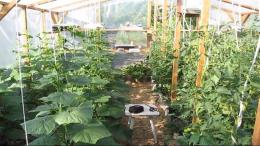Search
Login
Recommended
Planting seedlings in a greenhouse, timing, method of planting: peppers, tomatoes, cucumbers, cabbage
Unfortunately, weather conditions do not always contribute to the cultivation of a high-quality crop of vegetables under the open sky. Sudden changes in temperature during the day, frequent rains or too dry air - these factors have a significant impact on the volume and quality of agricultural products. Therefore, vegetable growers often resort to the option of growing crops such as cucumbers, tomatoes, peppers in a protected ground, i.e. in the greenhouses.
Content:
- The best materials for the greenhouse - seedlings in a polycarbonate greenhousevideo
- When to plant cucumber seedlings in a greenhouse
- Proper soil preparation. planting pepper seedlings in a greenhouse
- Planting cabbage in a greenhouse
- Planting tomato seedlings in a greenhouse
The best materials for the greenhouse - seedlings in a polycarbonate greenhouse
Gardeners with some experience claim that it is in a polycarbonate greenhouse that you can grow a lot of good vegetables.

First of all, the design itself provides the most comfortable microclimate for plants:
- there are no gaps in it,
- active sunlight does not harm the vegetative part of plants
- there is an opportunity to arrange the proper ventilation of the room
The second, but no less important point is the lack of need for removing the ceiling for the winter period. This fact makes it possible to begin to carry out the necessary spring work in an earlier period.

It is important to know that it is mandatory to process the elements of the greenhouse with the composition of lime, especially in cases when the fruits were ripened and during the growth of the plant. In addition, the earth in the greenhouse also needs to be replaced.
A solution of bleach can be prepared as follows: for 1 bucket of water you need 400 grams of dry product. Processing must be thorough. The composition must be applied to all fragments of the structure.
Details on the assembly of the polycarbonate greenhouse - in the video:
When to plant cucumber seedlings in a greenhouse
Cucumbers are a crop that, if desired, can be grown as in a container with earth located on the windowsill, in greenhouse conditions or in open ground. Particular attention should be paid to seedlings of cucumbers when transplanting. They tolerate it quite poorly. Maximum effort and attention should be made when transplanting seedlings from small containers into a greenhouse.

Growing a plant like a cucumber in greenhouse conditions will delight gardeners with a good harvest. In greenhouses, cucumbers will receive a sufficient amount of moisture and heat, so the duration of their growth will increase significantly, and fruiting will occur even in the cool season.
To obtain seedlings, seeds are placed in containers with soil around the beginning of April. In cases where the greenhouse is equipped with heating, the seeds can be planted immediately in the greenhouse soil. Otherwise, the seeds are placed in small containers (flower pots, disposable cups and the like) with fertilized soil located on the windowsill. After some time and reaching the seedlings of the required size - transplant into the greenhouse.
It is worth noting that the normal conditions for good seedling growth are temperatures of at least 18 - 20 degrees and access to sunlight.
cucumber seedlings turn yellow - determine the cause of the disease
There are times when grown seedlings begin to turn yellow.

Reasons for this may include:
- seedlings have reached a certain size and the root system is closely in capacity with the ground
- there is not enough nitrogen in the ground and it requires top dressing
- the plant suffers from an overabundance of fertilizers (top dressing is made in a volume much larger than was necessary)
- lack of sunlight
- the appearance of pests of various kinds.
we make fertilizers in a timely manner
Feeding can only begin after the first leaf has appeared. It is produced in the morning, before watering, with a complex fertilizer containing a certain percentage of nitrogen.
In cases where the plant independently develops at the proper pace, top dressing is done only before planting, two days before the process.
For seedlings developing poorly in greenhouse conditions, fertilizing with formulations containing phosphate, potassium, sulfur, nitrogen will be needed. Spend it at least 1 time in 10 days.

Around the middle of autumn, after the last harvest, the greenhouse soil is fed with fertilizers (compost + potassium + phosphorus) and carefully digged.
In the spring, some time before planting, the soil is treated with a solution - a disinfector. Such a procedure is of particular and important importance. Greenhouse conditions are an excellent environment for the development and reproduction of various harmful microorganisms. Disinfection treatment will impede their development.
About a week before the seedlings are planted in the greenhouse, the soil in it should be enriched with nitrogen compounds and heated.
Do this as follows:
- 1 tsp urea is distributed per square meter
- dig the ground carefully
- in hot water (about 70 degrees) breed chicken droppings
- water the composition and cover it with a film
planting seedlings in a greenhouse
Planting of plants can be done only after at least 4 -5 leaves appear on each seedling. By this time, the daily greenhouse temperature should be at least 20 degrees. Too high a temperature is not desirable for seedlings, so it can lead to various undesirable changes in growth, and sometimes to complete withering. To avoid such problems, during the construction of the greenhouse, they either provide vents that can be opened at the right time, or open the door and thus maintain the required temperature.

Only after the soil has been warmed up and all the necessary fertilizing has been applied can we begin to plant the plants in the soil. The holes are staggered, while observing the distance between them at least half a meter. Depth should be about 15 - 20 centimeters.

In each of the holes you need to pour a liter of heated water. In water for irrigation, you can add a certain amount of manganese. It will prevent the development of diseases in seedlings, as well as disinfect water.
The earth in pots with seedlings is watered. As accurately as possible, seedlings are removed from the pots. Then the cucumbers are placed in the holes in an upright position and sprinkled with earth so that cotyledon leaves remain on the surface.

Since cucumbers belong to the family of climbers, it is necessary to take care of the support. To do this, twine or wire is suitable. Fasteners must be of high quality and durable. The load on the support will become very significant over time. Basically, twine fasteners are produced to trellises horizontally located in the upper part of the greenhouse.
When the formation of 9-10 leaves is completed on the seedling, the stem is wrapped around the support and attached to it. Periodically (it all depends on the growth rate of the plant), the garter is repeated.
About the landing of cucumbers - in more detail:
features of care for seedlings of cucumbers in the greenhouse

Pursuing the cultivation of greenhouse cucumbers, beginning gardeners make the following mistakes:
- too close to the seedlings in relation to each other leads to frequent diseases, as plants can exchange infections with the help of contacting leaves. Ideal location - this is the presence of 1 square. meter no more than 4 seedlings.
- the use of organic fertilizers that have not undergone special processing - fertilizers of this kind suggest the presence of insect larvae - pests or adults, which can cause irreparable damage to plants.
- the formation of a draft when ventilating the greenhouse - airing should be done as follows: first open the window on one side, then, closing it, open the window located on the other side.
- watering seedlings in excess of the norm - watering should be organized only after the upper part of the soil becomes dry. An excess of fluid promotes the spread of rot and other formations that have a negative effect on plants.
- untimely harvesting - until the grown fruits are collected, the plant does not receive a signal for the formation of new ovaries.
Proper soil preparation, planting pepper seedlings in a greenhouse
A greenhouse bed before planting pepper should be carefully prepared. Pepper is a plant very sensitive to various diseases and insects - pests. Therefore, it is necessary to disinfect the earth.

If the plants in the greenhouse get sick quite often, as an additional disinfection, a pink potassium permanganate solution can be poured into each well.
Pepper cannot grow and bear fruit in soil with high acidity. Therefore, the control of the PH must be constant. You can lower the acidity of the soil with dolomite flour.
Fertilizing pepper seedlings is best done with natural ingredients. For example, it can be rotted manure. Fertilizer is evenly distributed on the surface of the soil, and then gently mixed.
Before planting pepper in a greenhouse, the soil needs to be marked out. The aisles should be at least 40 cm. What distance to leave between the bushes depends on what kind of pepper is preparing for planting: tall or short.

Pepper seedlings that have reached the age of 70-80 days can be planted in the soil of the greenhouse. The temperature in the structure at night should be about 17 - 20 degrees. At a lower temperature, there is a risk of inhibition in the development of plant growth and, as a consequence, the later appearance of mature fruits.

The optimum depth of the hole for planting pepper should correspond to the depth of the dishes. in which seedlings were grown. It will be better if the seedlings are not planted on a hot day. So the plants will receive less stress during transplantation. For the first time, planted seedlings are best shaded with special materials.
Planting cabbage in a greenhouse
The growing process is simple and very effective. Cabbage easily tolerates temperature changes. The only thing you should pay constant attention when growing is the appearance of such insects as cruciferous fleas and aphids. And if they are found, immediately take measures to prevent their further reproduction.

In cases where the cabbage seedlings will be transplanted into the open ground over time, the greenhouse a few days before this is completely opened and left in this form. This will allow the plants to harden and prepare for less comfortable growth conditions.
Before transplanting, seedlings are fed with compounds with minerals and increase the percentage of potassium present. In order not to exceed the permissible dose of potassium, it can be replaced with wood ash. A solution is made from it and introduced into the ground, it is it that is considered a natural substitute for potassium.

At about 60 days, young sprouts of cabbage have 6 leaves and grow to a height of 25 cm. By this time, the tops are quite saturated with bright green color. Seedlings of this kind are ready for transplanting. Saplings having a different, less attractive condition, are not transplantable.
The choice of a place in the garden under the cabbage should be treated responsibly. You should not choose a place where, for example, radishes, radishes or lettuce grew last season. A good place will be after potatoes, carrots, legumes or onions.
Planting tomato seedlings in a greenhouse
In the greenhouse you can also grow an excellent tomato crop, but you need to pay due attention to the preparation of the soil.

As fertilizer for each square meter, it is recommended to make:
- humus bucket floor (fresh manure must not be used!)
- 1 glass of ash
- one and a half tablespoons of complex mineral fertilizers
The beds are dug up and planned. The best option is to plant plants in one row, the distance between the bushes is about 45 cm. The temperature suitable for planting seedlings is from +20 C to +25 C.
The depth of the holes is a minimum of 15 cm. In each make 1 glass of humus, Art. a spoonful of wood ash, half a teaspoon of superphosphate, stirred with soil. For watering the wells using a pale pink solution of potassium permanganate.

It is difficult to indicate the landing dates, because they depend on the weather conditions of a particular region. As a rule, they plant in the first decade of May - this is if the greenhouse is not heated. But you need to follow the weather forecast - if it is expected to lower the temperature - you will need to install additional arches inside the greenhouse and pull spanboards over the seedlings. If this is not possible, you should not rush into the landing.
Planting a tomato in a greenhouse should be chosen in accordance with the varieties and method of forming bushes. It is not recommended to thicken the planting - the plants are photophilous tomatoes, everyone should have enough sun and light to form and ripen the fruits.
tomato planting schemes in a greenhouse
There is no consensus on the landing schemes, each lover has his own preferences and secrets.
As for the general rules, they are as follows:
- low-growing, formed in two stems varieties can be planted at a distance of 0.5 m, staggered
- the distance between the standard plants can be reduced to 0.25 m, while the distance between the rows will be 0.5 m.
- for indeterminate varieties, it is optimal to place plants at a distance of 0.6 m in a row, rows to be placed at a distance of 0.8 m, if you plan to form plants in two stems, then the distance between the bushes should be increased to 0.75 m.

You can use the combined version of planting - determinant early ripening varieties are planted at the wall, we will form them in 1 stalk, in the second row, we plant tall plants closer to the path, we also form in one stalk.
With this formation of bushes, we get an early crop, but there will not be many tomatoes. With the formation of two or three stems, the number of fruits will increase significantly, but there is a chance that they will not have time to ripen.
Prepared seedlings are placed in the wells, if the seedlings have optimal sizes - they are placed vertically, if it has outgrown - with an inclination. At the same time, part of the stem that will be sprinkled with soil is freed from the leaves.
Watering the planted tomatoes is carried out under a bush, 2 liters of water are enough for 1 plant.
About planting tomato seedlings in a greenhouse - clearly in the video:
soil mulching
To reduce the amount of watering, reduce air humidity and simplify the care of plants, the soil in the greenhouse is mulched.

For mulch use:
- straw, grass
- cardboard, non-woven black cover material
- peat
The optimum thickness of a layer of straw or grass is about 5 cm.
care features

Further care for the seedlings in the greenhouse will be:
- spraying with a solution of copper oxychloride or Bordeaux liquid - as protection against late blight and brown spotting
- maintaining air temperature within +25 С
- ventilating the greenhouse, which will help reduce air humidity to the optimum level
- timely feeding.





